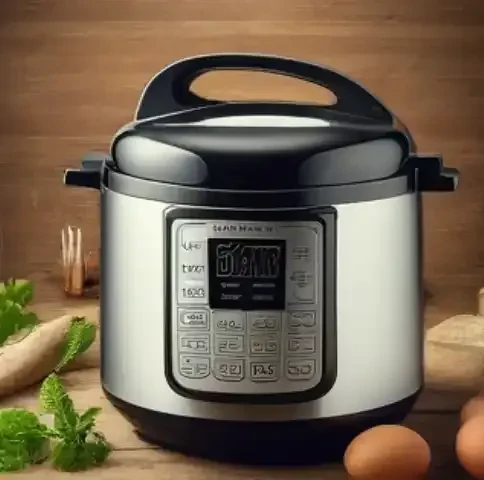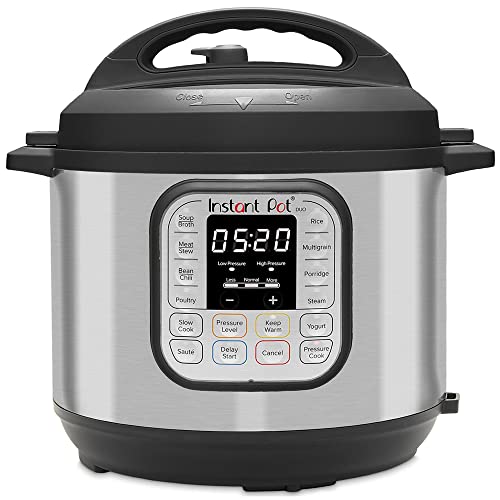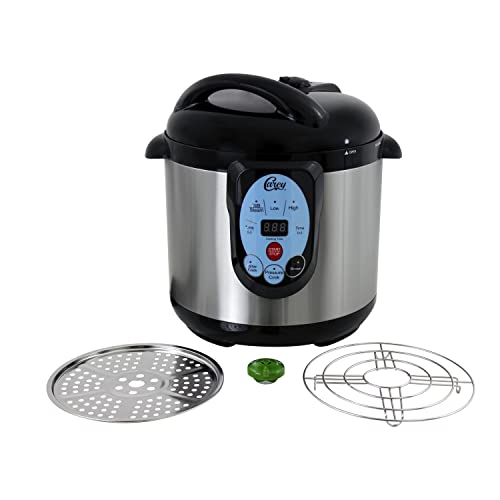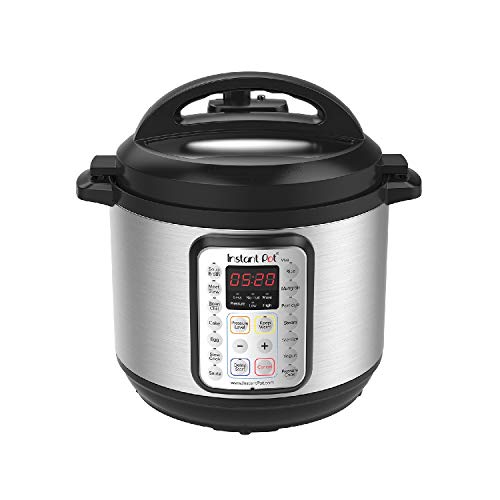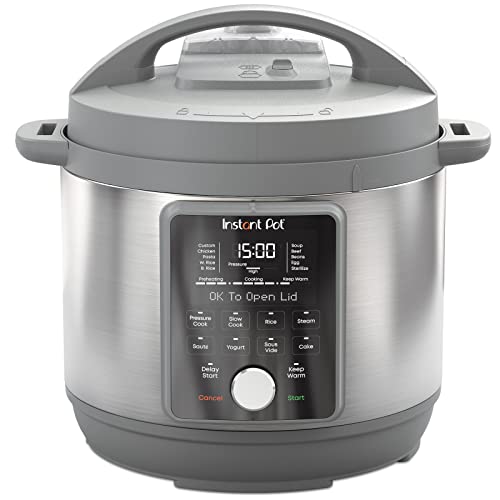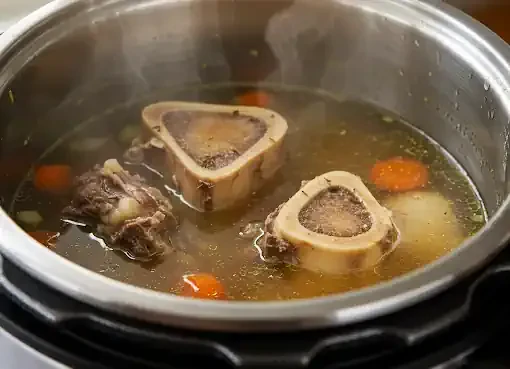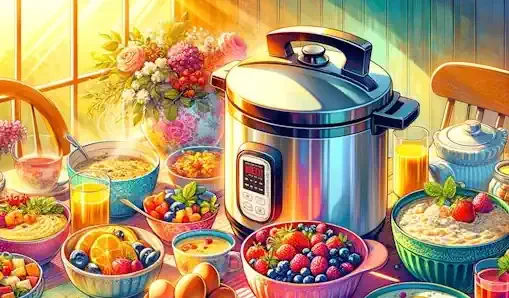Introduction
Electric pressure cookers have emerged as indispensable kitchen appliances, revolutionizing the way we cook and saving time, energy, and effort. These modern marvels combine the benefits of pressure cooking with the convenience of electricity, making them accessible and user-friendly for cooks of all skill levels. In this comprehensive guide, we'll delve into the world of electric pressure cookers, exploring their functionality, advantages, common uses, and tips for optimal usage.
Definition and Purpose
An electric pressure cooker, also known as an electric Instant Pot or multi-cooker, is a versatile kitchen appliance designed to cook food quickly and efficiently under pressure. Unlike traditional stovetop pressure cookers, which rely on the heat of a stove burner, electric pressure cookers are powered by electricity, featuring built-in heating elements that regulate temperature and pressure automatically.
The primary purpose of an electric pressure cooker is to reduce cooking time significantly while retaining the flavor, nutrients, and texture of food. By sealing in steam and increasing pressure, these devices raise the boiling point of water, allowing food to cook faster than conventional methods. Whether you're preparing soups, stews, grains, meats, or desserts, an electric pressure cooker can streamline the cooking process without compromising taste or quality.
Brief History of Electric Pressure Cookers
The concept of pressure cooking dates back to the 17th century when French physicist Denis Papin invented the steam digester, an early precursor to the modern pressure cooker. Over the centuries, pressure cooking evolved, with stovetop pressure cookers becoming popular household appliances in the mid-20th century.
The introduction of electric pressure cookers in the late 20th and early 21st centuries marked a significant advancement in convenience and safety. Early electric models were often bulky and limited in functionality, but as technology improved, so did the design and features of electric pressure cookers. Today, these appliances come in various sizes and configurations, equipped with programmable settings, safety mechanisms, and advanced cooking functions.
Growing Popularity and Appeal
In recent years, electric pressure cookers have experienced a surge in popularity, driven by their efficiency, versatility, and time-saving benefits. Busy individuals and families appreciate the ability to prepare wholesome meals in a fraction of the time it would take using traditional cooking methods. Additionally, the set-it-and-forget-it nature of electric pressure cookers allows users to multitask or attend to other responsibilities while their meal cooks.
Furthermore, the rise of online communities, recipe sharing platforms, and cookbooks dedicated to electric pressure cooking has contributed to its mainstream appeal. Home cooks are continually discovering new ways to utilize their electric pressure cookers, from weeknight dinners to batch cooking for meal prep. As more people seek convenient yet nutritious meal solutions, electric pressure cookers have become a staple appliance in modern kitchens worldwide.
How Electric Pressure Cookers Work
Electric pressure cookers operate on a simple yet ingenious principle, harnessing the power of steam and pressure to expedite the cooking process. Understanding the mechanics behind these devices sheds light on their efficiency and safety features.
Basic Mechanics
At the core of an electric pressure cooker lies a sealed cooking chamber, typically made of stainless steel, with a removable inner pot. This chamber is equipped with a heating element, which heats the pot and its contents to generate steam. Unlike traditional cooking methods where food is cooked in an open pot, the sealed environment of an electric pressure cooker traps steam, raising the internal pressure.
As the temperature and pressure inside the cooker increase, the boiling point of water rises, allowing food to cook at higher temperatures than under normal atmospheric pressure. This elevated temperature significantly reduces cooking time, making it possible to prepare dishes that would traditionally require hours in a fraction of the time.
Electric pressure cookers feature a control panel with various settings and programs, allowing users to customize cooking parameters such as time, pressure, and temperature. Once the desired settings are selected, the cooker automatically regulates the cooking process, adjusting temperature and pressure as needed to achieve optimal results.
Safety Features
One of the primary concerns with pressure cooking is the potential for accidents due to high pressure and temperature. However, modern electric pressure cookers are equipped with multiple safety features to mitigate these risks and ensure user confidence.
Pressure Release Valve: This valve allows excess steam to escape from the cooker, preventing pressure buildup beyond safe levels. It typically features multiple release settings, including a quick-release option for rapid depressurization at the end of the cooking cycle.
Lid Locking Mechanism: Electric pressure cookers are designed with secure locking mechanisms that prevent the lid from being opened when the cooker is pressurized. This prevents accidental burns or spills caused by releasing steam under pressure.
Pressure Sensors: Built-in sensors monitor the internal pressure of the cooker and automatically adjust the heating element to maintain safe operating conditions. If the pressure exceeds predetermined limits, the cooker may enter a safety shutdown mode to prevent overheating or damage.
Temperature Control: Precise temperature control ensures that food is cooked evenly and thoroughly without the risk of burning or scorching. Advanced electric pressure cookers may feature sensors and algorithms that optimize cooking parameters based on the selected recipe or food type.
By incorporating these safety features, electric pressure cookers offer peace of mind to users, allowing them to enjoy the convenience of pressure cooking without compromising on safety.
Advantages Over Traditional Cooking Methods
The efficiency and versatility of electric pressure cookers provide several distinct advantages over traditional cooking methods
Time Savings: Electric pressure cookers can reduce cooking times by up to 70%, making them ideal for busy individuals and families with limited time for meal preparation.
Energy Efficiency: By cooking food faster and with less water, electric pressure cookers consume less energy compared to conventional stovetop cooking methods.
Retained Nutrients: The sealed environment of pressure cooking helps retain vitamins, minerals, and flavors that may be lost during prolonged cooking times.
Tenderization: Pressure cooking breaks down tough fibers in meats and legumes, resulting in tender and flavorful dishes in a fraction of the time required by traditional methods.
Overall, electric pressure cookers offer a convenient, safe, and efficient way to prepare a wide range of dishes, making them a valuable addition to any kitchen.
Benefits of Using an Electric Pressure Cooker
Electric pressure cookers offer a plethora of benefits that cater to the needs and preferences of modern cooks. From time and energy savings to enhanced flavor retention, these appliances have transformed the way we approach meal preparation. Let's explore the various advantages of incorporating an electric pressure cooker into your culinary repertoire.
Time Efficiency
One of the most significant advantages of using an electric pressure cooker is its ability to dramatically reduce cooking time. Traditional cooking methods often require hours of simmering or braising to achieve tender and flavorful results. In contrast, an electric pressure cooker can accomplish the same feat in a fraction of the time, thanks to its ability to cook food under high pressure.
For example, a tough cut of meat that would typically take hours to tenderize through slow cooking methods can be transformed into a succulent dish in under an hour with an electric pressure cooker. Similarly, dried beans and legumes, which traditionally require soaking and long cooking times, can be cooked to perfection in a matter of minutes in a pressure cooker.
This time-saving aspect of electric pressure cookers is particularly appealing to busy individuals and families who juggle multiple responsibilities and have limited time for meal preparation. With an electric pressure cooker, you can enjoy homemade meals without sacrificing hours of your day to cooking.
Energy Efficiency
In addition to saving time, electric pressure cookers are also highly energy-efficient appliances. Unlike conventional cooking methods that rely on prolonged heat exposure from stovetops or ovens, pressure cooking utilizes a sealed environment and rapid cooking process to conserve energy.
Because electric pressure cookers cook food faster and require less water compared to traditional methods, they consume significantly less energy. This translates to lower electricity bills and reduced environmental impact, making pressure cooking an eco-friendly cooking alternative.
Furthermore, the energy efficiency of electric pressure cookers extends beyond the cooking process itself. Many models feature insulated housing and energy-saving modes that help retain heat and minimize energy loss during operation. By maximizing energy efficiency, electric pressure cookers offer a sustainable solution for home cooking.
Nutritional Benefits
Contrary to popular belief, pressure cooking preserves the nutritional value of food by minimizing nutrient loss during the cooking process. The sealed environment of an electric pressure cooker traps steam and heat, preventing water-soluble vitamins and minerals from leaching into the cooking liquid.
Additionally, the shorter cooking times associated with pressure cooking help preserve the color, texture, and flavor of fruits and vegetables. Unlike boiling or steaming, which can lead to nutrient degradation through prolonged exposure to heat and water, pressure cooking locks in nutrients while retaining the natural integrity of ingredients.
This nutritional preservation makes electric pressure cookers an ideal cooking method for health-conscious individuals who prioritize nutrient-rich meals. Whether you're cooking fresh produce, lean proteins, or whole grains, an electric pressure cooker allows you to maximize the nutritional benefits of your ingredients without compromising on taste or texture.
Flavor Retention
One of the most remarkable aspects of electric pressure cooking is its ability to intensify and enhance the natural flavors of ingredients. The high-pressure environment forces liquid and seasoning to penetrate deep into the food, resulting in rich and well-developed flavors.
Moreover, the rapid cooking process of electric pressure cookers helps preserve the natural aromas and essences of ingredients, resulting in dishes that are vibrant, aromatic, and full of depth. From hearty stews and braises to delicate soups and risottos, electric pressure cooking allows you to create complex and nuanced flavors with minimal effort.
Furthermore, the sealed environment of an electric pressure cooker prevents flavors from escaping during the cooking process, ensuring that every bite is packed with taste. This flavor-retention aspect of pressure cooking makes it an invaluable tool for home cooks who seek to elevate their culinary creations and impress their taste buds.
In summary, the benefits of using an electric pressure cooker extend far beyond convenience, encompassing time efficiency, energy savings, nutritional preservation, and flavor enhancement. Whether you're a busy professional, a health-conscious cook, or a flavor enthusiast, an electric pressure cooker offers a multitude of advantages that can transform your cooking experience for the better.
Common Uses and Recipes
Electric pressure cookers are incredibly versatile appliances that can be used to prepare a wide range of dishes, from comforting soups and stews to flavorful meats and grains. Their ability to cook food quickly and efficiently makes them indispensable tools for home cooks seeking convenience without compromising on taste. Let's explore some common uses and popular recipes for electric pressure cookers
Versatility in Cooking
One of the key features of electric pressure cookers is their versatility in cooking a variety of foods. Whether you're craving a hearty meal for a cold winter's night or a light and nutritious dish for a summer evening, an electric pressure cooker can accommodate a wide range of culinary preferences and dietary restrictions.
From main courses to side dishes, appetizers to desserts, electric pressure cookers can handle it all. They excel at cooking tough cuts of meat to perfection, transforming them into tender and succulent dishes in a fraction of the time required by traditional methods. Additionally, electric pressure cookers are ideal for preparing beans, lentils, and grains, which can be cooked quickly and evenly without the need for soaking or constant monitoring.
Moreover, electric pressure cookers are excellent for making one-pot meals that require minimal cleanup. By combining ingredients in the inner pot and letting the pressure cooker work its magic, you can create delicious and satisfying meals with minimal effort and mess.
Popular Dishes to Make
Beef Stew: A classic comfort food, beef stew is the perfect dish to prepare in an electric pressure cooker. Tender chunks of beef, hearty vegetables, and savory broth come together in a fraction of the time, resulting in a satisfying meal that's perfect for chilly evenings.
Chicken and Rice: This one-pot meal is a staple in many households, and an electric pressure cooker makes it even easier to prepare. Juicy chicken thighs, aromatic rice, and flavorful seasonings cook together effortlessly, resulting in a wholesome and comforting dish that's sure to please the whole family.
Vegetable Soup: Loaded with fresh vegetables, herbs, and spices, vegetable soup is a nutritious and delicious meal that's perfect for any occasion. With an electric pressure cooker, you can whip up a batch of homemade vegetable soup in no time, allowing the flavors to meld together beautifully for a satisfying and soul-warming dish.
Chili: Whether you prefer meaty or vegetarian chili, an electric pressure cooker is the perfect tool for making this hearty and flavorful dish. With its ability to tenderize beans and infuse spices, an electric pressure cooker allows you to create a rich and robust chili that's perfect for game days, potlucks, or cozy nights in.
Cheesecake: Yes, you read that right – you can even make dessert in an electric pressure cooker! Cheesecake lovers rejoice, as an electric pressure cooker can produce creamy and decadent cheesecakes with minimal effort. Simply prepare the cheesecake batter, pour it into a springform pan, and let the pressure cooker work its magic for a luscious and indulgent treat.
Adaptation of Traditional Recipes
In addition to popular dishes specifically designed for electric pressure cookers, many traditional recipes can also be adapted to take advantage of the speed and convenience they offer. For example, recipes that call for braising, simmering, or slow cooking can often be converted to pressure cooking with minor adjustments to cooking times and liquid ratios.
Similarly, classic recipes like risotto, risotto, and even homemade yogurt can be prepared in an electric pressure cooker with excellent results. By following pressure cooking guidelines and experimenting with different settings and ingredients, you can adapt your favorite recipes to make them even more convenient and delicious.
Overall, electric pressure cookers offer endless possibilities for home cooks looking to streamline their meal preparation without sacrificing flavor or quality. Whether you're a novice cook or a seasoned chef, an electric pressure cooker can help you create delicious and satisfying meals with ease, making it a valuable addition to any kitchen arsenal.
Tips for Using an Electric Pressure Cooker
While electric pressure cookers are relatively straightforward to use, mastering their full potential requires an understanding of best practices and techniques. Whether you're a novice or seasoned user, these tips will help you maximize the efficiency and effectiveness of your electric pressure cooker while ensuring safe and delicious results
Proper Usage and Safety Guidelines
Read the Manual: Before using your electric pressure cooker, thoroughly read the user manual provided by the manufacturer. Familiarize yourself with the various functions, settings, and safety features of the appliance to ensure proper usage.
Check Seals and Valves: Before each use, inspect the sealing ring and pressure release valves to ensure they are clean, intact, and properly positioned. A secure seal is essential for maintaining pressure and preventing accidents during cooking.
Avoid Overfilling: To prevent liquid from spilling or clogging the pressure release valve, avoid overfilling your electric pressure cooker. Most models have a maximum fill line that should not be exceeded when adding ingredients and liquid.
Use Sufficient Liquid: Pressure cooking requires adequate liquid to generate steam and build pressure. Refer to your recipe or the manufacturer's guidelines for recommended liquid ratios, especially when cooking grains, beans, and thick sauces.
Release Pressure Safely: When the cooking cycle is complete, use caution when releasing pressure from the cooker. Depending on the recipe, you can either perform a quick pressure release by manually opening the pressure release valve or allow natural pressure release by letting the cooker depressurize on its own.
Cooking Time Adjustments
Factor in Preheating Time: Electric pressure cookers require time to build pressure before the cooking cycle begins. Account for preheating time when planning your meal to ensure accurate timing and prevent undercooking.
Adjust Cooking Times: While electric pressure cookers excel at reducing cooking times, some recipes may require adjustments to achieve optimal results. Experiment with cooking times based on the type and quantity of ingredients, as well as personal preferences for texture and doneness.
Consider Food Density: Dense ingredients such as large cuts of meat or root vegetables may require longer cooking times to become tender. Conversely, delicate foods like seafood and leafy greens may require shorter cooking times to avoid overcooking.
Use High-Quality Ingredients: Fresh, high-quality ingredients will yield the best results when using an electric pressure cooker. Choose fresh produce, lean meats, and quality spices to enhance the flavor and nutritional value of your dishes.
Cleaning and Maintenance
Follow Cleaning Instructions: After each use, clean your electric pressure cooker according to the manufacturer's instructions. Remove the inner pot, sealing ring, and pressure release valve for thorough cleaning, and wipe down the exterior of the cooker with a damp cloth.
Deodorize Naturally: If your electric pressure cooker develops odors over time, try natural deodorizing methods such as placing a bowl of vinegar or lemon slices inside the cooker and running a steam cycle. This will help eliminate lingering smells without using harsh chemicals.
Inspect Regularly: Periodically inspect your electric pressure cooker for signs of wear and tear, including damaged seals, loose parts, or malfunctioning components. Promptly replace any worn or defective parts to ensure safe and reliable operation.
Store Properly: When not in use, store your electric pressure cooker in a cool, dry place away from direct sunlight and moisture. Avoid stacking heavy items on top of the cooker, as this may damage the housing or lid.
By following these tips for using an electric pressure cooker, you can enjoy safe, efficient, and delicious cooking results every time. With practice and experimentation, you'll become proficient in harnessing the full potential of this versatile kitchen appliance, opening up a world of culinary possibilities in your own home.
Comparison with Other Cooking Appliances
In a market saturated with various kitchen appliances, it's essential to understand how electric pressure cookers stack up against other cooking devices. While each appliance has its strengths and limitations, comparing them can help you make informed decisions about which tool best suits your cooking needs and lifestyle.
Differences from Stovetop Pressure Cookers
Stovetop pressure cookers have been around for much longer than their electric counterparts and operate on similar principles of sealed cooking under pressure. However, there are several key differences between the two
Heat Source: Stovetop pressure cookers rely on an external heat source, such as a gas or electric stove, to generate heat and build pressure. In contrast, electric pressure cookers have built-in heating elements that regulate temperature and pressure automatically.
Control and Monitoring: Electric pressure cookers typically offer more precise control over cooking parameters, with programmable settings and digital displays that allow users to monitor temperature, pressure, and cooking time. Stovetop pressure cookers require manual adjustment of heat settings and monitoring of pressure levels.
Convenience: Electric pressure cookers are often favored for their convenience and ease of use. They can be set to cook unattended, allowing users to multitask or leave the kitchen while their meal cooks. Stovetop pressure cookers require more hands-on attention and supervision during the cooking process.
Portability: Stovetop pressure cookers are generally more portable and versatile, as they can be used on any stovetop or portable heat source. Electric pressure cookers, on the other hand, require access to a power outlet and may be less convenient for outdoor or off-grid cooking.
Contrast with Slow Cookers
Slow cookers, also known as crock-pots, are beloved for their ability to simmer food slowly over several hours, resulting in tender and flavorful dishes. While electric pressure cookers and slow cookers share some similarities, they have distinct differences
Cooking Time: Slow cookers are designed for long, slow cooking at low temperatures, often taking several hours or even overnight to cook a meal. In contrast, electric pressure cookers excel at cooking food quickly under high pressure, reducing cooking times to a fraction of what slow cookers require.
Texture and Flavor: Slow cookers are prized for their ability to tenderize meats and develop rich flavors through prolonged cooking. Electric pressure cookers can achieve similar results in a fraction of the time, though the texture and flavor profile may differ slightly due to the faster cooking process.
Versatility: Electric pressure cookers are more versatile than slow cookers, as they can be used to sauté, steam, and even bake in addition to pressure cooking. Slow cookers are limited to slow cooking and may require additional steps or equipment for other cooking methods.
Convenience: While slow cookers are convenient for set-it-and-forget-it cooking, electric pressure cookers offer greater flexibility and speed, making them suitable for busy individuals and last-minute meal preparation.
Advantages Over Microwave and Oven Cooking
Electric pressure cookers offer several advantages over microwave and oven cooking methods
Speed: Electric pressure cookers cook food much faster than ovens and microwaves, making them ideal for busy weeknights or when time is of the essence.
Flavor Retention: Pressure cooking helps retain the natural flavors and nutrients of ingredients better than microwave cooking, which can often result in dried-out or unevenly cooked dishes.
Versatility: Electric pressure cookers offer more cooking methods and flexibility compared to microwaves, which are primarily used for reheating and quick cooking. They can sauté, steam, and even bake in addition to pressure cooking, providing a wide range of culinary possibilities.
Energy Efficiency: Electric pressure cookers consume less energy than conventional ovens, making them a more environmentally friendly option for cooking.
Overall, while each cooking appliance has its own unique strengths and applications, electric pressure cookers offer a winning combination of speed, versatility, and convenience that make them a valuable addition to any kitchen. Whether you're looking to whip up quick weeknight meals or experiment with new recipes, an electric pressure cooker can help you achieve delicious results with minimal effort.
Market Overview and Recommendations
As the popularity of electric pressure cookers continues to soar, the market has become flooded with a wide array of options, ranging from budget-friendly models to high-end, feature-rich appliances. Navigating this diverse landscape can be overwhelming, but understanding key factors and considerations can help you make an informed decision when selecting an electric pressure cooker.
Popular Brands and Models
Instant Pot: Instant Pot has emerged as a dominant player in the electric pressure cooker market, offering a diverse range of models to suit various cooking needs and budgets. The Instant Pot Duo series is particularly popular, featuring multiple cooking functions, safety features, and user-friendly controls.
Ninja Foodi: Ninja Foodi electric pressure cookers are known for their versatility, combining pressure cooking, air frying, and crisping capabilities in one appliance. The Ninja Foodi Deluxe series offers advanced features such as dual-zone cooking and smart cook programs for effortless meal preparation.
Crock-Pot Express: Crock-Pot Express electric pressure cookers are favored for their simplicity and reliability. With intuitive controls and preset cooking programs, Crock-Pot Express models are ideal for beginners or those seeking hassle-free cooking solutions.
Breville Fast Slow Pro: Breville Fast Slow Pro electric pressure cookers are renowned for their precision and performance. With customizable cooking settings, advanced temperature and pressure controls, and a durable stainless steel construction, the Fast Slow Pro is a top choice for discerning home cooks.
Budget-Friendly Options
For those on a budget, there are plenty of affordable electric pressure cookers that offer excellent value for money. Consider the following budget-friendly options
Cosori Electric Pressure Cooker: Cosori electric pressure cookers combine affordability with versatility, featuring multiple cooking functions, safety features, and a user-friendly interface.
Power Pressure Cooker XL: Power Pressure Cooker XL models are budget-friendly options that offer basic pressure cooking functionality without sacrificing performance or reliability.
Gourmia Electric Pressure Cooker: Gourmia electric pressure cookers are known for their affordability and simplicity. With intuitive controls and preset cooking programs, Gourmia models are ideal for budget-conscious shoppers.
Considerations for Purchase
When choosing an electric pressure cooker, there are several factors to consider to ensure you select the right appliance for your needs
Size and Capacity: Electric pressure cookers come in various sizes, ranging from small models suitable for singles or couples to larger models ideal for families or batch cooking. Consider your typical batch size and kitchen space when selecting the appropriate capacity.
Cooking Functions: Determine which cooking functions are essential for your cooking style and preferences. While most electric pressure cookers offer basic pressure cooking functionality, some models include additional features such as slow cooking, sautéing, steaming, and yogurt making.
Safety Features: Look for electric pressure cookers with robust safety features, including pressure release valves, lid locking mechanisms, and overheat protection. These features help prevent accidents and ensure safe and reliable operation.
Ease of Use: Choose an electric pressure cooker with intuitive controls and a user-friendly interface. Models with preset cooking programs and customizable settings make it easier to achieve consistent and delicious results with minimal effort.
Build Quality and Durability: Opt for electric pressure cookers with durable construction and high-quality materials, such as stainless steel inner pots and sturdy housing. A well-built appliance is more likely to withstand frequent use and last for years to come.
In conclusion, the electric pressure cooker market offers a wide range of options to suit every budget, cooking style, and preference. By considering factors such as brand reputation, features, and durability, you can find the perfect electric pressure cooker to elevate your culinary adventures and simplify meal preparation in your kitchen.
Conclusion Electric Pressure Cooker
The electric pressure cooker has revolutionized the way we cook, offering convenience, versatility, and efficiency that have transformed meal preparation in kitchens around the world. As we conclude our exploration of this remarkable kitchen appliance, it's clear that electric pressure cookers have earned their place as essential tools for home cooks of all skill levels.
Recap of Electric Pressure Cooker Advantages
Throughout this guide, we've highlighted the numerous advantages of electric pressure cookers
Time Efficiency: With the ability to cook food in a fraction of the time required by traditional methods, electric pressure cookers are a boon for busy individuals and families.
Energy Efficiency: By reducing cooking times and minimizing energy consumption, electric pressure cookers offer a more sustainable and environmentally friendly cooking alternative.
Nutritional Benefits: The sealed environment of pressure cooking helps retain vitamins, minerals, and flavors, making electric pressure cookers an ideal choice for health-conscious cooks.
Flavor Retention: Pressure cooking intensifies and enhances the natural flavors of ingredients, resulting in rich and flavorful dishes that delight the senses.
Versatility: From soups and stews to meats and desserts, electric pressure cookers can handle a wide range of recipes and cooking techniques, offering endless possibilities for culinary creativity.
Future Trends and Innovations
Looking ahead, we can expect to see continued innovation and evolution in the electric pressure cooker market. Manufacturers are likely to focus on developing advanced features, improving ease of use, and expanding cooking capabilities to meet the diverse needs of consumers.
Smart technology integration, such as Wi-Fi connectivity and app-based controls, may become more prevalent, allowing users to monitor and control their electric pressure cookers remotely from their smartphones or tablets. Additionally, advances in materials and construction may lead to more durable and efficient electric pressure cookers that withstand the rigors of everyday use.
Final Thoughts on the Utility of Electric Pressure Cookers
In closing, the electric pressure cooker has become an indispensable tool for modern home cooks seeking convenience, efficiency, and delicious results in the kitchen. Whether you're whipping up quick weeknight dinners, experimenting with new recipes, or batch cooking for meal prep, an electric pressure cooker offers unparalleled versatility and performance.
As you embark on your culinary journey with your electric pressure cooker, remember to experiment, explore, and embrace the endless possibilities it offers. With a bit of creativity and a willingness to try new things, you'll soon discover why the electric pressure cooker has earned its status as a kitchen essential for cooks of all backgrounds and tastes. Happy cooking!
